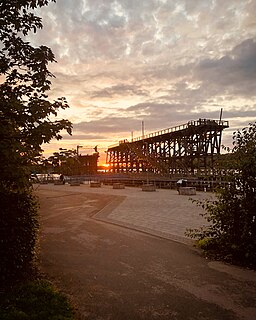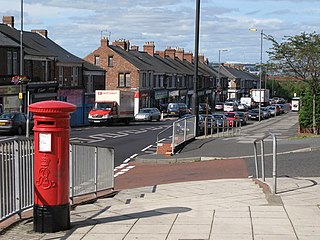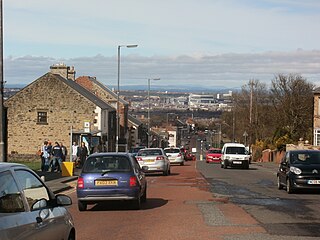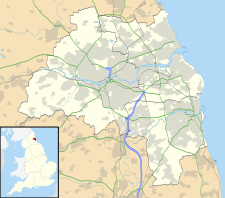
Gateshead is a large town in North East England and principal settlement of the Metropolitan Borough of Gateshead, situated on the southern bank of the River Tyne. Gateshead is joined to Newcastle via seven bridges across the Tyne, including the Gateshead Millennium Bridge. The town is known for its architecture, including the Sage Gateshead, the Angel of the North and the Baltic Centre for Contemporary Art. Residents of Gateshead, like the rest of Tyneside, are usually referred to as Geordies. Gateshead's town population in 2011 was 120,046.

The Metropolitan Borough of Gateshead is a metropolitan borough in the metropolitan county of Tyne and Wear, North East England. It is named after its largest town, Gateshead, but the metropolitan borough incorporates the surrounding area including Rowlands Gill, Whickham, Blaydon, Ryton, Felling, Pelaw, Dunston and Low Fell. The borough forms part of the Tyneside conurbation, centred on Newcastle upon Tyne.

Metrocentre is a shopping centre and entertainment complex in the Dunston area of Gateshead. It is located on the former site of Dunston Power Station, near to the River Tyne.

Meanwood is a suburb and former village in north-east Leeds, West Yorkshire, England.

Nocton is a village and civil parish in the North Kesteven district of Lincolnshire, England. It is situated on the B1202 road, 7 miles (11 km) south-east from Lincoln city centre. The population of the civil parish at the 2011 census was 819. To the east of the village is Nocton Fen with its small settlement of Wasps Nest. To the west of the village, situated at the junction of Wellhead Lane and the B1188 road, is Nocton Top Cottages consisting of 8 further dwellings. At the south of the village are the remains of Nocton Hall, and 1 mile (2 km) to the east the earthwork remains of Nocton Park Priory.

Dunston is a western area of the town of Gateshead on the south bank of the River Tyne, in the Metropolitan Borough of Gateshead, North East England. Dunston had a population of 18,326 at the 2011 Census.

Deckham is a residential suburb in the Metropolitan Borough of Gateshead in Tyne and Wear, England. It is bordered by Gateshead town centre to the north, Sheriff Hill to the south, Felling and Carr Hill to the east and Shipcote to the west. It lies on the B1296, the route of the old Great North Road, 1 mile (1.6 km) south of Gateshead town centre, 1.5 miles (2.4 km) south of Newcastle-upon-Tyne and 13 miles (21 km) north of the city of Durham. In 2011, Deckham had a population of 9,938.

Sheriff Hill is a suburb in the Metropolitan Borough of Gateshead in Tyne and Wear, England. It lies on the B1296 road 2 miles (3.2 km) south of Gateshead, 2.5 miles (4.0 km) south of Newcastle upon Tyne and 12 miles (19 km) north of the historic city of Durham. According to the 2001 UK census it had a population of 5,051.

The Royal United Hospital (RUH) is a major acute-care hospital in the Weston suburb of Bath, England, which lies approximately 1.5 miles (2.4 km) west of the city centre. The hospital has 565 beds and occupies a 52 acres (21 ha) site. It is the area's major accident and emergency hospital, with a helicopter landing point on the adjacent Lansdown Cricket Club field. The hospital is operated by the Royal United Hospitals Bath NHS Foundation Trust.
Kingsmeadow Community Comprehensive School is a school for 11- to 18-year-olds based in Dunston, Metropolitan Borough of Gateshead. It was opened in 1990 on the site of Dunston Comprehensive School, combining the existing Saltwell Senior High, Dunston Comprehensive and Hillhead Junior High schools. The school's name came from Kings Meadow Island in the Tyne, which was dredged away in the nineteenth century to allow large ships up the river. The school has been awarded specialist Business and Enterprise College status.

Low Fell is a suburb of Gateshead situated in the Metropolitan Borough of Gateshead in Tyne and Wear, England. Built predominantly on sandstone, grindstone and clay, it is bordered by Sheriff Hill/Deckham to the east, Saltwell/Bensham to the west, Harlow Green to the south and Shipcote to the north. The suburb lies on a major bus route 2.5 miles south of Gateshead centre, 3 miles south of the city of Newcastle upon Tyne and 12 miles north of the historic City of Durham. The principal road in the suburb is the A167. According to the 2001 UK census, the suburb had a population of 8,643, falling marginally to 8,636 at the 2011 census.

Lobley Hill is located in the west of the old County Borough of Gateshead within the Metropolitan Borough of Gateshead in Tyne and Wear, North East England having been previously part of the parish of Whickham.

Dunston Power Station refers to a pair of adjacent coal-fired power stations in the North East of England, now demolished. They were built on the south bank of the River Tyne, in the western outskirts of Dunston in Gateshead. The two stations were built on a site which is now occupied by the MetroCentre. The first power station built on the site was known as Dunston A Power Station, and the second, which gradually replaced it between 1933 and 1950, was known as Dunston B Power Station. The A Station was, in its time, one of the largest in the country, and as well as burning coal had early open cycle gas turbine units. The B Station was the first of a new power station design, and stood as a landmark in the Tyne for over 50 years. From the A Station's opening in 1910 until the B Station's demolition in 1986, they collectively operated from the early days of electricity generation in the United Kingdom, through the industry's nationalisation, and until a decade before its privatisation.

The Stella power stations were a pair of now-demolished coal-fired power stations in the North East of England that were a landmark in the Tyne valley for over 40 years. The stations stood on either side of a bend of the River Tyne: Stella South power station, the larger, near Blaydon in Gateshead, and Stella North power station near Lemington in Newcastle. Their name originated from the nearby Stella Hall, a manor house close to Stella South that by the time of their construction had been demolished and replaced by a housing estate. They operated from shortly after the nationalisation of the British electrical supply industry until two years after the Electricity Act of 1989, when the industry passed into the private sector.

Hedgeley Hall is a privately owned late 18th-century country house situated near Powburn, Northumberland, 8 miles (13 km) northwest of Alnwick. It is a Grade II listed building.

Derwent Tower was a 29-storey residential apartment building in Dunston, Tyne and Wear, United Kingdom, opened in 1972. Due to its unusual shape it was nicknamed the "Dunston Rocket" during construction and the name remained with locals throughout its life. It was demolished in 2012.

The Queen Elizabeth Hospital is based in Sheriff Hill in Gateshead, England. It is managed by Gateshead Health NHS Foundation Trust.

Windy Nook is an area in Tyne and Wear, England, bordered by Carr Hill to the west, Whitehills Estate and Leam Lane Estate to the east, Felling to the north and Sheriff Hill to the south. It lies on steep, sloping land 2.25 miles (3.62 km) south of Gateshead, 2.75 miles (4.43 km) south of Newcastle upon Tyne and 12 miles (19 km) north of Durham. In 2011, the Windy Nook and Whitehills ward had a population of 9,781. Formerly part of Heworth, it was incorporated into the newly formed Metropolitan Borough of Gateshead on 1 April 1974.

Carr Hill is a suburb in the Metropolitan Borough of Gateshead in Tyne and Wear, England. It is bordered by Felling to the north, Sheriff Hill to the south, Windy Nook to the east and Deckham to the west. It lies 1.5 miles (2.4 km) south of Gateshead, 2 miles (3.2 km) south of the city of Newcastle upon Tyne and 13 miles (21 km) north of the historic City of Durham. Once a village in County Durham, it was incorporated into the Metropolitan Borough of Gateshead by the Local Government Act 1972 on 1 April 1974.
Gateshead Health NHS Foundation Trust run the Queen Elizabeth Hospital, Gateshead, Dunston Hill Hospital, QE Metro Riverside and some services at Bensham Hospital, within Gateshead, Tyne and Wear, England. They also run services from Blaydon Primary Care Centre and Washington Primary Care Centre.



















